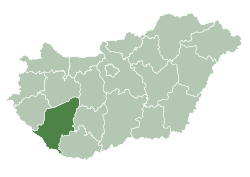Csurgó
Csurgó (formerly Somogy-Csurgó, Croatian: Čurguj / Čurgov) is a town in Somogy county, Hungary and the seat of Csurgó District.
Csurgó Somogy-Csurgó (formerly) Čurguj / Čurgov (in Croatian) | |
|---|---|
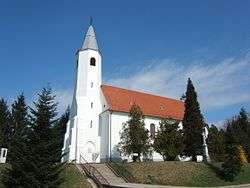 Szentlélek-templom (English: Holy Spirit Church) in Csurgó | |
 Flag 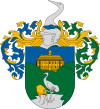 Coat of arms | |
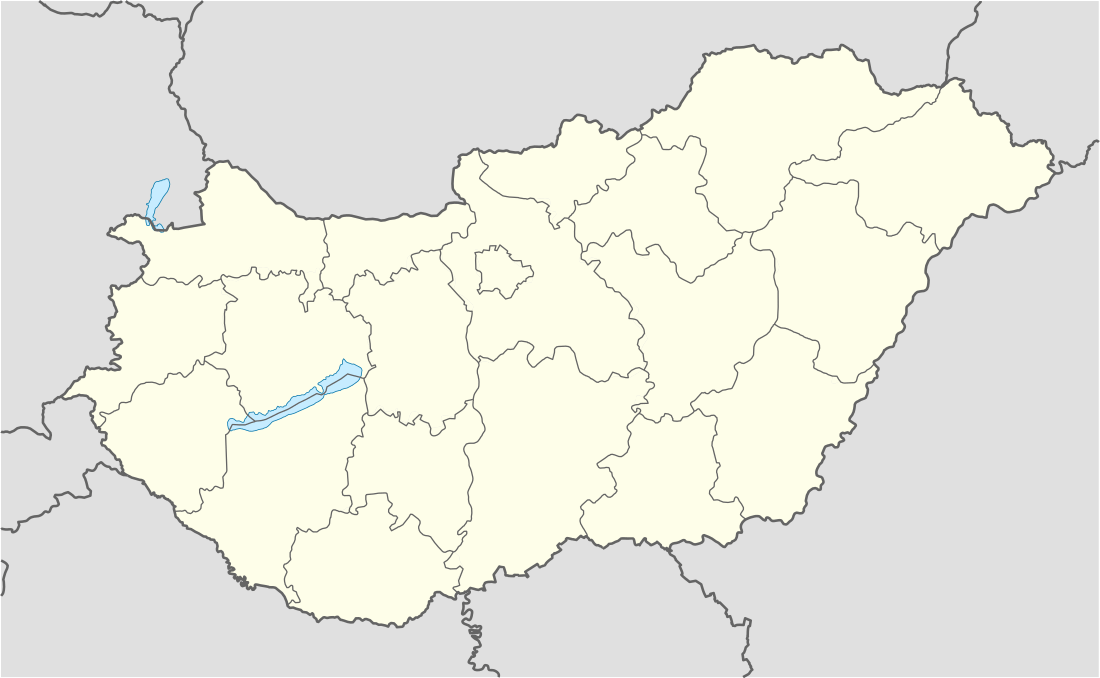 Csurgó Location of Csurgó | |
| Coordinates: 46.256978°N 17.097975°E | |
| Country | |
| Region | Southern Transdanubia |
| County | Somogy |
| District | Csurgó |
| RC Diocese | Kaposvár |
| Area | |
| • Total | 59.6 km2 (23.0 sq mi) |
| Population (2017)[1] | |
| • Total | 4,806[2] |
| Demonym(s) | csurgói |
| Time zone | UTC+1 (CET) |
| • Summer (DST) | UTC+2 (CEST) |
| Postal code | 8840 |
| Area code | (+36) 82 |
| Patron Saint | Holy Spirit |
| NUTS 3 code | HU232 |
| MP | László Szászfalvi (KDNP) |
| Website | Csurgó Online |
The settlement is part of the Balatonboglár wine region.[3]
Geography
It lies on the southwestern part of Somogy County, near the Hungarian-Croatian border. Here meets the Öreghegy (English: Old Mountain) and the Újhegy (English: New Mountain) in Northwest, the Inner Somogy Hill Range in the Northeast and the River Drava in the South. The town can be approached by car or train. It lies on the Dombóvár-Gyékényes Railway Line.
History
The territory of Csurgó was already inhabited in prehistoric times according to archaeological finds. During the Roman times this place was on the road which connected Pannonia province to the Adriatic Sea. Csurgó was first mentioned in the establishing charter of the Abbey of Zalavár in 1019 when Saint Stephen of Hungary donated the village and its goods to the Benedictine monks. During the Árpád era it was one of the lands of the free royal swineherds. Then later the sister of Béla III, Margit gave it to the Crusaders. They settled on the so-called Felső-Csurgó (English: Upper Csurgo) part of the village on a hill in a marsh. Then later the Order of Malta arrived on that place. The Johanniter Order founded their first monastery between 1217 and 1226 which served as a fortress, hospital and church. According to the legends Béla IV fled through Csurgó after the Battle of Muhi where he stayed for a night and drank from the Holy Mary Well. Csurgó was given market town rights on September 28, 1405 by Sigismund Luxemburg. Its castle was built in the 15th century but was demolished in the 18th century. There was also a church built in the 13th century which was repeatedly rebuilt since 1731. Sebestyén Tinódi Lantos moved here in 1543 and stayed for two years after his lord was captured by the Turks. During the Turkish occupation the town lost most of its residents.
In the beginning of the 18th century Csurgó was almost empty and belonged to the Festetics family who decided to revive the settlement. They allowed Hungarians, Germans, Croats and Slovaks to settle in the village. Its Calvinist secondary school was founded in 1792. Also the famous Hungarian poet, Mihály Csokonai Vitéz taught there between the May 26, 1799 and February 17, 1800. He finished his well-known work, Dorottya there. between 1804 and 1809 Csurgó belonged to György Festetics.[4]
Csurgó became market town again in 1850. Since 1896 he operates the first training school in Somogy County. The town became seat of the Csurgó District in 1871. The section of the train line connecting Budapest to Fiume (today Rijeka, Croatia) near Csurgó was finished in 1872. It became third time a town in 1989.
Main sights
- Town Museum
- Szentlélek-templom (English: Holy Spirit church) - built in the 13th century, later rebuilt in Baroque style, the tower is in Romantic style
- Csokonai Reformed Secondary School - built in the 18th century in Eclecticism
- Csokonai Community House
- Town Library
- Sport Hall
- Meller Mansion - built in the 19th century in Eclecticism with Secession decoration
- Basa Well - built in the 16th century by Damat Ibrahim Pasha
- Lake Zis - famous recreational and hiking spot
Culture
The Hungarian folk song A juhásznak jól van dolga was collected in Alsok (part of Csurgó) in 1898 by Béla Vikár.
Twin towns — sister cities
Csurgó is twinned with:








Notable residents
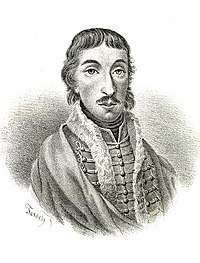
- Mordecai Benet born 1753, a Talmudist and chief rabbi of Moravia
- László Szászfalvi (born 1961), Hungarian Calvinist pastor, theologian, politician, mayor of Csurgó (1990 - 2003, 2006 - 2010)
- Ludwig Lichtschein (? - 1886), Hungarian rabbi
- László Faragó (1906 – 1980) military historian, journalist
- Antal Stevanecz (1861 – 1921), Slovene teacher and writer
- Attila Bárkányi (born 1947), Hungarian designer
- Ferenc Beleváry (1801 - 1878), Hungarian Reformed pastor
- Sebestyén Tinódi Lantos (c. 1510 – 1556), Hungarian lyricist, epic poet, political historian, minstrel
- Mihály Csokonai Vitéz (1773 - 1805), Hungarian poet, teacher
- Ernő Kiss Angyal (1899 - 1968), Hungarian composer
- Elemér Nádasdi Sárközy (1900 – 1988), Hungarian painter, restaurateur
- Máté Lajos Csurgói (1931 - 2001), Hungarian painter, graphic designer
- Lajos Nacsa, Hungarian Catholic priest
- Dezső Laky (1887–1962), Hungarian statistician, economist, minister
- József Bokor (1843 – 1917), Hungarian philosopher, author
- Magda Hadik (1914 – 2004), Hungarian sculptor
Gallery
 Statue of Saint Stephen of Hungary
Statue of Saint Stephen of Hungary Building of the Csokonai Secondary School
Building of the Csokonai Secondary School
See also
- Slovenes in Somogy
References
- Gazetteer of Hungary, 1st January 2015. Hungarian Central Statistical Office.
- Csurgó, KSH
- A Balatonboglári borvidék hegyközségi tanácsának alapszabálya (PDF)
- László Szita : Somogy megyei nemzetiségek településtörténete a XVIII-XIX. században - Somogyi Almanach 52. (Kaposvár, 1993)
- "International Exchange". List of Affiliation Partners within Prefectures. Council of Local Authorities for International Relations (CLAIR). Archived from the original on 21 November 2015. Retrieved 21 November 2015.
- Gerő, L. (1984): Magyar műemléki ABC. (Hungarian Architectural Heritage ABC.) Budapest
- Genthon I. (1959): Magyarország műemlékei. (Architectural Heritage of Hungary). Budapest
- Szőnyi O. (É.n.): Régi magyar templomok. Alte Ungarische Kirchen. Anciennes églises Hongroises. Hungarian Churches of Yore. A Műemlékek Országos Bizottsága. Mirályi Magyar Egyetemi Nyomda, Budapest.
- Gerevich T. (1938): Magyarország románkori emlékei. (Die romanische Denkmäler Ungarns.) Egyetemi nyomda. Budapest
- Henszlmann, I. (1876): Magyarország ó-keresztyén, román és átmeneti stylü mű-emlékeinek rövid ismertetése, (Old-Christian, Romanesque and Transitional Style Architecture in Hungary). Királyi Magyar Egyetemi Nyomda, Budapest
External links
| Wikimedia Commons has media related to Csurgó. |
- Official website in Hungarian, English, German and Croatian
